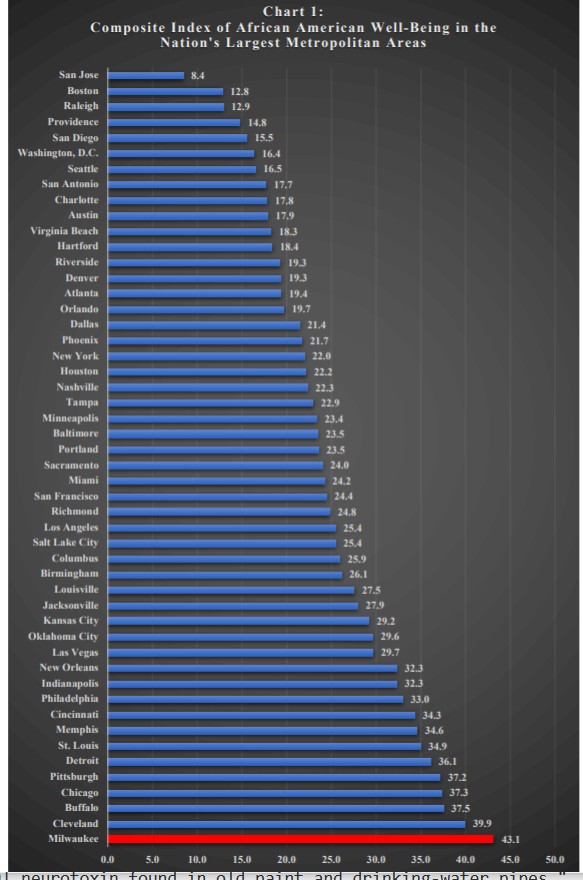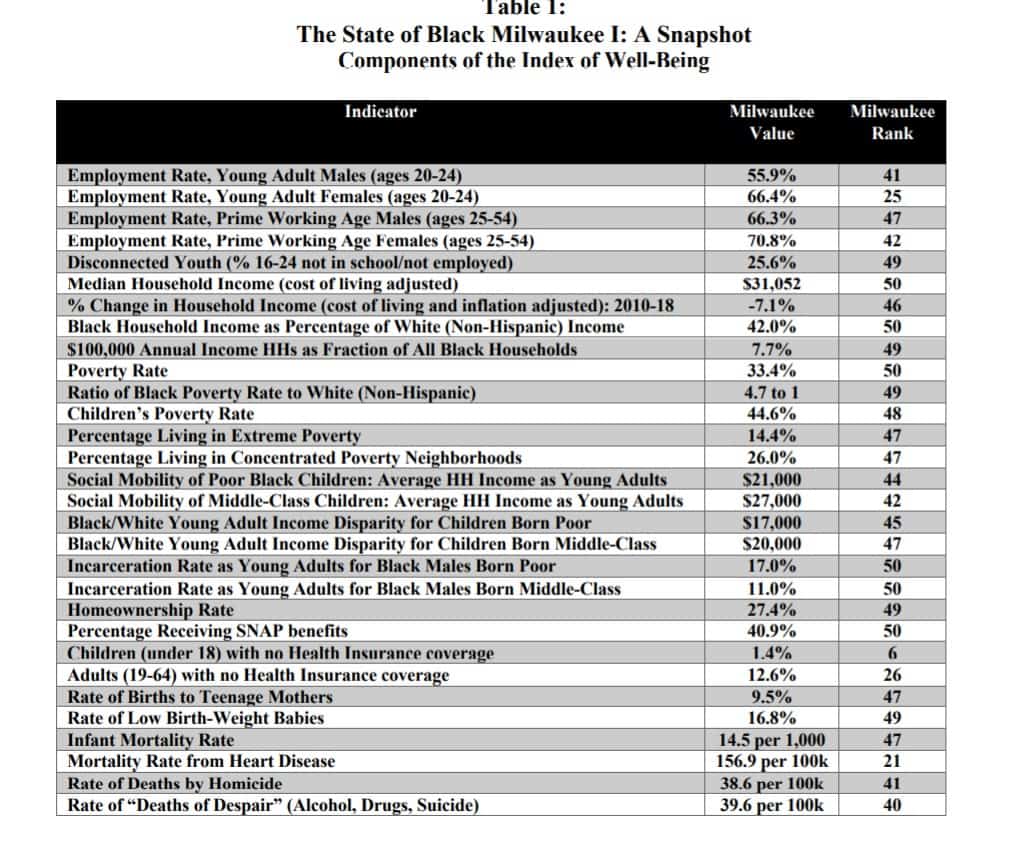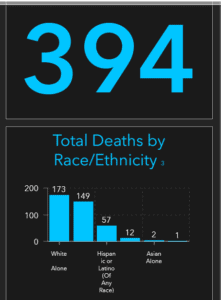The Democratic National Convention, which launches in Milwaukee on Aug. 17, is likely to focus, at least partly, on race. Perhaps Democrats should look close to home: Mayor Tom Barrett, and his failed leadership when it comes to Milwaukee’s Black community.
A strong case can be made that Barrett has failed Black Milwaukee. Yet the city’s protesters largely focused their anger on Milwaukee’s Mexican-American police chief instead. Alfonso Morales was a home-grown Milwaukee police chief, the son of a Mexican immigrant, and a man with deep roots in Milwaukee. He was a case study for the city’s vibrant diversity, a profile in the Milwaukee Journal Sentinel underscored – the first in his family to graduate from college, a chief comfortable conversing with residents in Spanish, and a hero who defended a courtroom from a gunman. Yet, Black Lives Matter joined forces with its friends on the Fire and Police Commission and succeeded in ousting him (the former has already moved on to trashing his successor, Michael Brunson, who is himself Black, online.)
Through this all, Barrett, a Democrat who appoints the Fire and Police Commissioners who pick police chiefs, has skated. Morales, who became the scapegoat for a movement that ignited because of an incident in another city, was only chief since 2018; Barrett has had more than 16 years (and he was a Congressman and state legislator before that) to improve the lives of Black Milwaukeeans and fix the racial disparities so severe they routinely land Milwaukee on the list of the worst cities in the country for Blacks to live.
It’s likely that the rhetoric at the DNC will focus on President Donald Trump and race, with little attention given to the disparities that exist in the Democratic-controlled city in the convention’s backyard, and the Democratic mayor’s responsibility for not fixing them.
Barrett’s job description encompasses the health and wellness of the entire city. By many measures, though, he has not succeeded in creating a Milwaukee where all can thrive. The extreme focus on police is diverting the conversation from issues that need addressing.
Emeritus UW-Milwaukee Professor Marc Levine published a study for the Center on Economic Development in July 2020 called, “The AALAM/UWMCED Index of African American Well-Being in the Nation the Nation’s Largest Metropolitan Areas.” The findings are scathing. To be sure, Levine’s study covers the Milwaukee metropolitan area, of which the City of Milwaukee is but a part, albeit a major driver. Thus, the failure is not Barrett’s alone. However, as the mayor of the largest city in the metro area for so many years where so much of the state’s Black population lives, the buck needs to also stop with him. (The Black population of the City of Milwaukee is about 230,000 people; the Black population of Wisconsin is about 368,000 people. Thus, the City of Milwaukee drives a lot of the disparities in the metro area and state as a whole as well.)
Levine wrote:
Milwaukee ranks, by a clear margin, at the bottom of all metro areas examined on the composite index of African American well-being. Most disturbingly, this poor performance is consistent on almost all the indicators for which we collected data to construct the index. Across the board, Milwaukee ranks dead last or near the bottom of the largest metropolitan areas in the country. The data are unambiguous: racial inequality remains deeply entrenched and pervasive in Milwaukee, and substantial improvement on numerous indicators will be necessary before Black Milwaukee reaches even the ‘middle-ofthe-pack’ on the index of African American well-being.
Levine’s report contains this stunning chart. Here’s how to read it: The number given to each city
“represents…the metro area’s average rank on the individual indicators comprised by the index (of African-American well-being). The higher the metro area index value, the worse the ‘average rank’ on the component indicators.” Milwaukee’s metro area is dead last.

Levine’s report encompassed a variety of socioeconomic ills. Milwaukee’s metro area ranked near the bottom of all states in most of them:

Levine’s report ticks off disparity after disparity, including:
- The percentage of “disconnected” Black youth in Milwaukee – those between the ages of 16-24 not in school or not working — is 25.6%, the second worst in the country;
- 17.0% of Blacks born in Milwaukee into poor households in the late 1970s and early 1980s were incarcerated by 2010, the worst incarceration rate in the country. The incarceration rate for Blacks born into middle-class households during that same period was 11.0%, also the worst in the country among large metro areas.
- Black median household income, adjusted for regional cost-of-living differences, is only $31,052, worst in the country; and Black household income in Milwaukee is only 42.0% of white non-Hispanic household income, the lowest percentage among large metro areas (and therefore the largest racial disparity in the country);
- Only 7.7% of all Black households in Milwaukee report annual income above $100,000; this is the second lowest rate of “affluent Black households” among the nation’s largest metros (only Cleveland reports a lower fraction of affluent Black households – 7.6%).
- Milwaukee’s Black homeownership rate of 27.4% is the second lowest in country; only Minneapolis posted a lower rate (25.2%). The homeownership rate, as numerous researchers have noted, is an important proxy measure of community wealth.
That’s not all. Consider:
How Tom Barrett Has Failed Black Milwaukee: The Mess at the Health Department & Failing Lead-Poisoned Children
We could start and end this column here, frankly. Not protecting children from lead? It’s hard to imagine there’s a more important task for a mayor. Barrett’s website claims that the “prevalence of children with significantly elevated blood lead levels” has dropped during his leadership. However, that doesn’t tell the whole story.
According to Milwaukee Magazine, Barrett appointed Health Commissioner Bevan Baker in 2004 right when he first became mayor. In January 2018, Baker quit when Milwaukee’s Health Department was rocked with dual scandals. As Milwaukee Magazine put it, Milwaukee’s Health Department “bungled two facets of its anti-lead program meant to protect children from the powerful neurotoxin found in old paint and drinking-water pipes.”
A blame game ensued. By 2019, Baker was blaming other departments and Barrett himself for the mess, according to The Milwaukee Journal Sentinel. The Journal Sentinel reported that Baker resigned because the Health Department “had failed to provide services for families of children with lead poisoning, or at least failed to document its efforts.”
“An internal Health Department report” found various mismanagement, according to the Journal Sentinel, including “staffing shortages, inadequate training, high turnover and poor coordination” that contributed “to the failure by its lead prevention program to follow up with thousands of families who had lead-poisoned children.”
The Largest Gap in Unemployment Between Blacks & Whites in the Country
Yes, you read that right. Metro Milwaukee has the largest gap in unemployment between Blacks and whites in the entire country, and the income gap disparity is second worst.
Milwaukee’s Black community has largely been left out of economic progress. The statistics come from the National Urban League in a May 2016 report.
According to CNN Business, that report “examined economic data for blacks in 70 metro areas and found that Milwaukee has the largest gap in unemployment between blacks and whites in the country and the second biggest income gap.”
According to the African American Leadership Alliance Milwaukee, “The African American population has greater economic disparities than virtually any of the peer metropolitan cities.”
The City Was Ranked the #1 Worst Place in the Country for Black People to Live
During Barrett’s leadership, Milwaukee was ranked the #1 worst place in the country for Black people to live. Need we say more?
According to a WPR story in 2019, “for the third year in a row, Milwaukee and Racine are among the worst cities in the United States for African Americans to live.” The report came from an organization called 247wallst.com.
“Milwaukee is one of the many Rust Belt cities where a history of redlining, exclusionary zoning, and discriminatory lending practices has contributed to segregation — that remains today — and to some of the largest racial disparities in income, health, and other socioeconomic measures in the country,” the site explains.
It concludes:
While nationwide some 16.8% of black Americans live in predominantly black neighborhoods, 35.2% of black Milwaukee residents do — the 20th largest share of any metro area.
The typical black household in Milwaukee earns just $29,928 a year, 43.8% of the median income of $66,097 among white households. Income is one of the primary correlates of health and longevity, and in Milwaukee, 1,020 in every 100,000 black residents die every year — over 300 more deaths per 100,000 than the white mortality rate, one of the largest disparities nationwide.
Black Graduation Rate
In March 2020, The Milwaukee Journal Sentinel reported that 90% of students in Wisconsin graduated from high school. However, only 69.1% of students in Milwaukee Public Schools graduated in four years in 2019. That was up slightly from 66.7% but remains a severe racial disparity.
“In Milwaukee, 78.4% of white students and 81% of Asian students graduated in four years, compared with 66.2% of black students and 70.2% of Hispanic students,” The Journal Sentinel noted.
Violent Crime
Violent crime in Milwaukee is skyrocketing. On July 3, Urban Milwaukee reported that the city’s homicide numbers had doubled and non-fatal shootings showed a 50 percent increase over the same point the year before.
It hasn’t abated. In August 2020, Fox 6 reported that the County Medical Examiner has reported 113 homicides through Aug. 6, 105 in the City of Milwaukee. “That puts Milwaukee on pace to top 175 homicides for the year, a figure not seen for nearly three decades,” the television station reported.
Domestic violence related homicides account for some of the increase. On July 10, Fox6 mapped the city’s homicides numbers over the years and found “Year after year, you can see that deadly violence plagues the same parts of the city while sparing others.”
COVID-19 Death Disparities
149 of Milwaukee County’s COVID-19 deaths were Blacks out of 394. That’s 38%. The County is 27% Black.

New York Magazine reported that COVID-19 disparities can be traced to overall health disparities.
As for overall mortality, New York Magazine reported that being “black in Wisconsin is analogous to having your life cut short by six years. From 2014 to 2016, black men there lived, on average, 7.34 years less than white men; black women lived 5.61 years less than white women, which is 115 percent higher than the national racial life-expectancy gap for women. In both cases, much of the divide is attributable to health disparities.”
Black Infants in Milwaukee Are More Likely to Die Than White Infants
According to the Children’s Health Alliance of Wisconsin, there is a racial disparity in infant mortality rates in Milwaukee.
“According to 2012-2015 data from the City of Milwaukee’s Fetal and Infant Mortality Review (FIMR) Committee, the white infant mortality rate was 4.9 per 1,000 births, while the black infant mortality rate was three times higher at 14.9 per 1,000 births. Additionally, the stillbirth rate was twice as high for African-American mothers: 9.7 versus 4.2 per 1,000 births,” the site reports.
The alliance cited many reasons for the “disproportionately high black infant mortality rate,” saying, “the earliest explanation suggested was socioeconomic; women with financial, housing or insurance issues had worse pregnancy outcomes, and perhaps more black women were in that category. However, data quickly showed that this did not explain the difference.”
Although Barrett’s website claims that overall infant mortality has dropped during his tenure, he admits, “African-American infants in Milwaukee are nearly three times more likely to die before their first birthdays compared to our white or Hispanic infants.” Furthermore, his website acknowledges, “the infant mortality rate remains high when compared to Wisconsin or the U.S. as a whole.”
Table of Contents







![Protecting Portland: No Good Deed Goes Unpunished [REVIEW]](https://www.wisconsinrightnow.com/wp-content/uploads/2025/07/portland-356x220.jpg)























